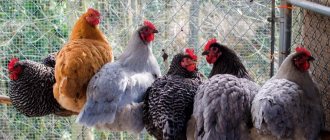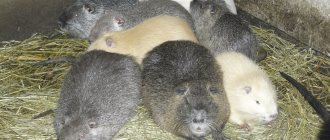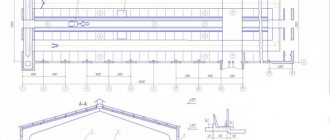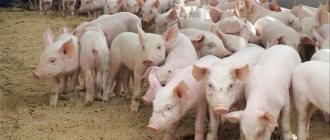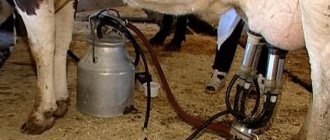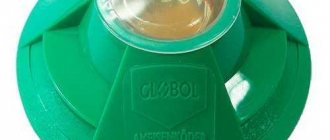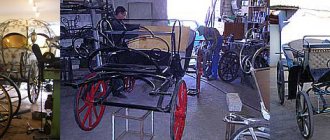Today's barns are increasingly prefabricated buildings in the form of an arched hangar. Modern technologies make it possible, when constructing a cattle farm for 100 heads, to abandon the classical type of structure due to the frameless type. Livestock buildings are now easier to construct and lower in cost. Complying with the required standards, the metal hangar is equipped in accordance with sanitary and hygienic conditions for the efficient maintenance of hundreds of cows.
Choosing a hangar type
The metal is lightweight and easy to use. When creating industrial facilities, it provides significant economic benefits and the shortest installation time. At the same time, facilities with proper arrangement and communications fully comply with the requirements for keeping cattle in favorable conditions.
The popularity of this type of hangar is not without reason:
- construction in the area of the month;
- the creation of a capital foundation is not necessary; support piles or a base in the form of a tape are often sufficient;
- the design is airtight and retains heat well (if it is insulated);
- no welding work, as is the case with frame hangars, which makes construction cheaper and faster;
- Due to the shape of the hangar, most precipitation does not linger on it.
A frameless arched hangar can be easily assembled in a short time, from metal sheets, right on the construction site. The steel is formed to the required parameters and is actually assembled as a constructor using a seam connection.
About business
The desire to open a pig farm from scratch begins with preparing a business plan. It initially contains a brief description, and then the main components. A ready-made business plan contains information about opening a mini-pig farm. To implement the idea, premises are rented.
The business plan has the following goals:
- opening a farm with a high profitability rate;
- the population receives pig products;
- profit is received from the sale of livestock or its products.
To open a small pig farm, you need to have a starting capital of approximately 1,897,000 rubles. This amount can also be obtained as a commercial loan.
Farm location
The barn is located away from residential buildings. It is best to build it over a fairly large area.
The placement location must meet the following criteria:
- Possibility of communication. The main thing is the electrics. It would also be nice to lay a water supply system. Of course, there is an alternative, because you can use an autonomous water supply; the pros and cons of one or another option depend on the location.
- Availability of roads nearby. They will allow easy transportation of cows and products.
- The landscape is best if it is hilly. On a hill, the hangar will be better protected from snow and mud slides in bad weather. During prolonged downpours, the hill will avoid flooding of the barn and avoid a number of flooding problems.
- The minimum distance from a populated area to a field with manure is 200 m (preferably further, since cows emit a strong odor); from the farm to the residential premises – 15 m.
A significant advantage of the location of the barn will be the presence of pastures nearby.
To avoid the risk of contamination of drinking water, farms are located away from wells and hydraulic facilities.
For industrial construction of this type, in addition to the hangar, it is necessary to consider a location for manure and other animal waste.
Challenges ahead
Farmers have to face various difficulties that are typical for pig farming:
- monopolization;
- African swine fever virus;
- additional tax on manure.
African plague is a dangerous virus and there is no vaccine against it. In a short period of time, the disease can destroy the entire livestock. If a plague outbreak is discovered, all animals are destroyed. Such measures lead to serious losses. It is not recommended to open a pig farm in regions where there have been outbreaks of plague.
Taxes are another obstacle for farmers. An entrepreneur needs to obtain a license to collect, further process, transport, and dispose of waste from keeping pigs. For a small farm, costs reach 100,000 rubles, for large farms - 400,000 - 20,000,000 rubles. You will have to obtain a waste passport and pay a tax for the negative impact of the environment. It is necessary to study a ready-made business plan for a pig farm to find out all the negative and positive aspects.
Monopolization continues to grow in this area. The state actively helps, but only to large farmers. Small entrepreneurs rely on their own resources, which leads to a number of problems:
- production costs increase;
- product quality decreases.
Farm construction stages
Frameless farms can be erected at any time of the year.
The stages of construction of such farms include:
- Development of design documentation for the construction of a livestock farm for 100 animals.
- Construction of a pile or strip foundation.
- Pouring the floor (concrete or laying conventional road slabs).
- Assembly of metal sheets into one supporting structure without the use of welding.
- Construction of production sections for keeping livestock and processing livestock products.
- Complete set of farms for cattle with heating, insulation and other communications, as well as their installation.
- Organization of ventilation in buildings for farm animals.
When building a metal truss, it is extremely important to ensure reliable fixation of the steel structure in accordance with frameless construction technology. This type of work requires the participation of professional craftsmen.
Market analysis
A well-developed business plan for a pig farm is part of success. Meat is a product that is in mass and daily demand. During a crisis, demand for it does not decrease. Of course, pricing policy plays a huge role. The main competitor of pig meat is chicken, as its consumption is constantly increasing.
Livestock farming in our country is a market segment in which there is an annual growth of 3%. This trend has continued over the past few years, resulting in the rise of agricultural businesses. As a result, there are investors who are ready to invest money and this allows them to push foreign competitors out of the market.
Over the past couple of years, our country has made a huge leap forward in pig farming. Production volumes will continue to increase. As of 2017, almost 90% of domestic consumption was provided by only 3 domestic meat. This resulted in a 26% increase in production.
Economists make positive forecasts for the future, which is confirmed by rising incomes. There are opportunities to even enter the global market.
Nowadays pig farming is one of the most promising and profitable types of business. It can be negatively affected by the import of imported products, increased prices, and decreased incomes of the population.
Farm lighting for cattle
When designing a frameless cattle farm for 100 heads, it is imperative to include the installation of windows in the project. Implementing them is important work. In a building with windows, drafts must be completely excluded. The barn will receive good natural light if the windows are installed on the south or east side.
Building a farm of 100 heads means placing windows at a height of 1m from the floor so that the cattle are not exposed to chilling.
It is necessary to wash the glass regularly, because dirt on the windows will not let the required amount of sunlight into the room.
Farms do not often have many windows; often after the construction of a barn, high-quality artificial lighting is provided inside.
Business plan (to build a good wooden or frame barn, costs for young animals, feed)
The cost of maintaining and raising cows for meat is determined by many parameters. This is the area of the territory, the number of livestock, materials for the construction of the barn and the costs of feeding and servicing the animals. At the beginning, significant costs will always be required, which will begin to pay off only after several calvings, since proceeds from the sale of dairy products can only partially cover the costs of maintaining cattle.
Read the business plan for cattle breeding here.
Costs for the workover device
Setting up a farm and purchasing the first livestock of animals and feed for them requires significant financial investments. The primary costs for organizing a cattle breeding business are:
- Land lease . The price directly depends on the area. In fertile areas with a mild climate, the cost of rent for farming needs is always higher. It is advisable to acquire the necessary space over time, which will significantly reduce costs. To raise 100 heads of livestock, at least 1 hectare of territory is required.
- Construction and equipment of a cowshed . This is one of the largest expenses at the beginning of production. It is profitable to build a shed on your own without hiring third-party workers. The cost of construction depends on the area of the barn and the automation of the process. Most often they resort to modern prefabricated standard barn layouts, where all the necessary communications are connected: water supply, electricity, sewerage, ventilation, etc.
- Purchase of animals . Initially, it is advisable to purchase several adult cows and bulls, as well as 10-12 heads of young animals. You should not immediately buy purebred and breeding animals, since most often they require special maintenance;
- Purchase of feed . It is purchased based on the number of livestock, the season of the year, and also taking into account the required feed. In summer, food costs are lower, since grazing is possible. In addition, you should immediately purchase all vitamins and feed additives;
- Hiring workers and paying wages . Self-maintenance of a farm with more than 15 cows is physically impossible. Therefore, it is necessary to hire employees to clean the premises, care for animals and collect products. The cost of veterinary care must also be included in the estimate.
Read about the feeding diet for dairy cows here.
The costs of setting up a business vary greatly depending on the location. In the southern and eastern regions, raising cows is cheaper, but it is important to understand that there is more competition in the market in these areas.
Profitability
Raising cattle is a profitable business, but this condition applies only to large farms with established sales channels. In the early stages, you will need to invest at least 1 million rubles for the arrangement of premises, the purchase of animals and feed. On average, the farm's payback period occurs no earlier than in 1.5-2 years, provided that meat and milk are constantly sold and new animals are purchased. Profitability largely depends on the productivity and health of livestock. If you create the right conditions, you can subsequently receive a stable income from the sale of replacement young stock, especially when raising productive breeds of cattle.
Read about keeping a cow on a private farm here.
Insulation and heating of the hangar
When keeping livestock on a farm, it is imperative to use a heating system. In a warm room, cows do not lose their weight; in a cold room, it always inevitably decreases, significantly. Therefore, the walls inside the barn should always be dry and warm.
The thermal conductivity properties of steel are low, so insulation requires special attention. High-quality insulation and its correct installation will allow you to significantly save on heating in winter.
The metal structure can either be sheathed with sandwich panels or insulated with polyurethane foam. Insulating the farm for the winter, in the climatic conditions of Russia, is a prerequisite for comfortable keeping of livestock.
Cows tolerate cold better than heat. Therefore, when calculating utility networks for heating, it is important to take this factor into account. Thus, the climate should reduce heat losses in winter and protect livestock from high temperatures in summer.
The desired climate indicators on the farm for cattle per 100 heads are from +10° to +20°. In areas with mild climates, simple eclectic heaters are sufficient. Where winters are long and cold, gas boilers are indispensable.
Insulated frameless hangars for livestock farming are used all year round. Thanks to the addition of sandwich panels or polyurethane foam, the hangar can withstand cold outside down to -50°. Also, insulating a farm hangar reduces noise, protects the facility from overheating and eliminates the greenhouse effect.
Hiring
Next, you need to resolve the issue with the farm staff, the number of which will depend on the volume of the enterprise. If you have a KFC, then the number of employees will include family members.
If your farm is medium-sized, then at first you will need at least two milkmaids and two workers . When production is automated, they will work in shifts. Organizational functions and accounting at the initial stage can be carried out by the entrepreneur.
In the future, the staff will be expanded to include other job units: manager, marketer, driver, and support workers. You cannot do without veterinarian services such as the prevention and treatment of diseases of the udder, reproductive system, and hooves. The cost of annual veterinary care will be 100 thousand rubles .
Barn ventilation
An industrial space for keeping livestock for 100 heads is equipped with an engineering system. Ventilation makes it possible to regulate the microclimate to normalize it. A well-functioning air exchange process eliminates the possibility of condensation forming in the room.
The ideal solution for a barn with a hundred animals is supply and exhaust ventilation. It happens that when a farm is set up on a hill and in a mild climate, farmers think that special ventilation slots are enough, but sooner or later everyone comes to installing active ventilation.
Interior arrangement of the farm
Inside, a cattle farm for 100 heads is equipped according to a pre-designed project. A whole range of zones necessary for effective breeding of cows is taken into account.
It consists of:
- Stable.
- Drinking bowl.
- Feeder.
- Litter.
- Manure storage facilities.
- Paddock for walking.
The material used to make the floor also matters.
Stalls
The suitable size of “cells” for cows is 1.2 m by 2.1 m. They are placed in 2 or 4 rows with mandatory intervals. When placing a cow in a stall, it must be tied. For this, a soft and strong rope no longer than 1.5 m is suitable. Calves' stalls are located close to cow stalls, most often through one partition. A properly made stall allows the animal to feel calm.
Drinkers and feeders
Standards for feeder sizes: height – 65 cm; width – 80 cm; length - 1-1.3 m. Boards and bricks can be used to create. It’s easier to make a drinking bowl and a feeding container next to the stalls, on the side of the animals’ heads. The feeder is often made in the form of an oblong trough, which makes it possible to supply food to dozens of cows at the same time. Experienced farmers use metal or plastic as materials - they are resistant to moisture and easy to clean.
It is advisable to have a central water supply. When the farm has 100 head of livestock, it is not advisable to carry water manually.
Bedding
Preferably from natural materials and that the layers are dense. You can use rubber or rubber mats.
Manure storage
Always made from waterproof material. Sloping floors are created in the stalls; waste flows into the storage area using special 20 by 20 cm gutters using special grooves. Such waste can be removed outside the barn through pipes.
Modern farms of 100 heads often implement a floor hydrocleaning system. When keeping a large number of livestock, the solution to using a manure conveyor located along the stalls has proven itself. The best results when cleaning manure are shown by cleaning with a delta scraper unit operating in auto mode.
Corral for walking
To properly raise cows, it is advisable to create a pen for walking. On its territory, livestock can walk and breathe fresh air. “Free” walking has a positive effect on the health of cows.
For a livestock of 100 units, the fencing of the pen should be made reliable to prevent it from being knocked down by animals. It is advisable to install a canopy to protect from precipitation and excessive sun.
The cow pen on the farm must always be kept clean. Any debris and manure must be removed from its perimeter.
Floor
For better cleaning process and hygiene, the floor is made with a slight slope in the direction of the manure receiver. The angle of inclination is 2 cm.
Pouring concrete or cement is completely suitable for arranging the floor of a barn. It is important that the animals do not lie on its “bare” surface. Wooden boards or straw padding as bedding will protect cows from chilling and mastitis.
An alternative to concrete flooring is a floor made of baked bricks. It's warmer. Brick floors are suitable for use for up to 10 years.
Financial plan
The payback period for investments after opening a farm for fattening bulls is about 2 years. Its duration is influenced by many factors:
- initial investment volume;
- the presence of a land plot owned by the investor;
- percentage of loss of young animals during fattening.
Fattening bulls for meat will be a successful business if you correctly calculate the amount of investments and current expenses and try not to go beyond these limits.
Investments in the project
Let's consider how much money it will take to open a small farm in the countryside:
- purchase of a small plot of land – 30,000;
- construction of a corral - 130,000;
- purchase of equipment – 100,000;
- purchase of 20 calves – 250,000.
The total investment amount is 510,000 rubles.
Current expenses
Monthly expenses include:
- expenses for feed for calves – 30,000;
- salary for two employees – 30,000;
- other expenses – 5,000.
Total: 65,000 rubles per month.
Calculation of profit and payback period of the project
Bulls are fattened until they are 14–16 months old, that is, for a year after purchase. Further keeping of animals is inappropriate. For 10 months of fattening, the farm owner will spend 650 thousand rubles. At the time of slaughter, the weight of the bull is 700 kg. Wholesale buyers offer 90–100 rubles for 1 kg of beef. Considering that the slaughter yield of meat from a carcass is 65%, the farmer will earn about 50 thousand rubles from the sale of each of them.
A livestock of 20 bull calves, under favorable circumstances, will bring the entrepreneur 1 million rubles a year after opening the farm . Investments in the project will fully pay off after 2 years of work.
Breeding bulls for meat is a profitable business. Its advantage is that you can start with a minimum amount of investment, buying 2-3 calves, or with a large capital. For those who live in the village and are familiar with the specifics of cattle breeding, this is a great idea with prospects for expansion.



